There are many sensitive components inside a microcontroller, and these components are very sensitive to external factors. If they are affected by electromagnetic interference, it can easily lead to the system not operating normally and stably. Therefore, electronic engineers must take reasonable measures to enhance the anti-interference performance of sensitive components. So how should this be done?

1. Optimize Wiring Design
First, the area of the loop should be minimized. A large loop area is more susceptible to external electromagnetic interference. Secondly, power and ground wires should be thickened to reduce voltage drop and lower coupling noise;
2. Properly Handle Idle I/O Ports
Idle I/O ports of the microcontroller and other IC devices should not be left floating but should be grounded or connected to power. This can prevent these ports from becoming noise reception points, thus improving the anti-interference performance of the entire circuit;
3. Use Power Monitoring and Watchdog Circuits
In microcontroller systems, using power monitoring and watchdog circuits (such as IMP809, IMP706, IMP813, X5043, X5045, etc.) can significantly improve the anti-interference performance of the entire circuit. These circuits can monitor the stability of the power supply voltage and perform reset operations when the system fails, thereby protecting sensitive components;
4. Reduce Operating Frequency
While meeting the system speed requirements, try to reduce the crystal oscillator frequency of the microcontroller and choose low-speed digital circuits, as high speed is more likely to encounter noise and interference issues;
5. Directly Solder IC Devices
To improve system stability and anti-interference performance, engineers can directly solder IC devices onto the circuit board and minimize the use of IC sockets, as IC sockets increase the connection points on the circuit board, thereby increasing the probability of noise/interference issues;
6. Others
In addition to the above measures, other methods can also be used to improve anti-interference performance, such as adding filters, shielding covers, etc. At the same time, during the design process, electromagnetic compatibility and electromagnetic interference issues should be fully considered to ensure system stability and reliability.
This article is an original work by Fan Yi Education, please indicate the source when reprinting!